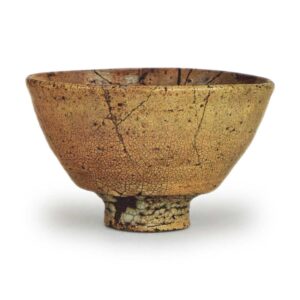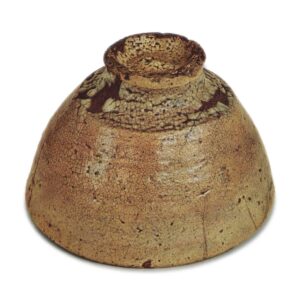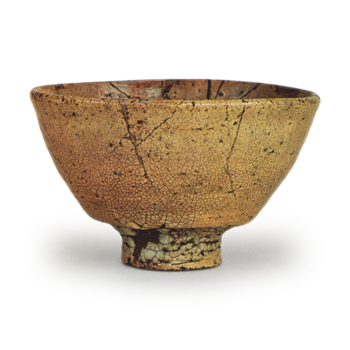

Important Cultural Property
Height: 9.3 – 9.8mm
Diameter: 15.2 – 15.5mm
Outer diameter of foot ring: 5.6 – 5.7mm
Height of foot ring: 1.9mm
There are around fifty Oido tea bowls that have been included in the collection, but there is little disagreement that Kizaemon and Tsutsui-tsutsumi are the two most outstanding examples in terms of their elegance and dignified appearance. If we were to sum up the characteristics of the two bowls in a few words, we could say that Tsutsui-tsutsumi is distinguished by its elegance, and Kizaemon by its dignified appearance.
The distinctive features of Tsutsui-tsutsumi are its shape, in other words, the balance between the width from the foot to the rim and the height of the whole, and the fact that the foot is deeply and boldly carved, giving the shape from the side a three-dimensional quality. In addition, the thickness of the glaze has an indescribable sense of “ma” (interval).
The glaze, which is commonly referred to as “biwa-iro” (loquat-colored), covers the entire surface, but if you look closely at the simple glaze, you will see that it is thick and thin in places, and therefore creates a rough and fine, subtle pattern of cracks, and the base of the bowl is rough and full of variety, creating a “kairagi” (Japanese plum bark) pattern that strongly tightens up the overall appearance. Despite the cracks of various sizes that are mentioned in anecdotes, it has retained its original generous appearance and has not lost any of its charm.
It is thought that the Ido tea bowl, which was displayed at the Kitano Grand Tea Ceremony held on the first day of the tenth month of the 15th year of the Tensho era and at which Hideyoshi himself performed the tea ceremony, was displayed alongside the Nitta Katsura, and it is thought that this Tsutsui Tsutsui may have been that bowl. on the back of the outer box, it is written, “It is said that Toyotomi Hideyoshi used it at the Kitano Grand Tea Ceremony, and that it was later called Tsutsui-tsubo because it was repaired after being damaged in error. There is also a theory that Hosokawa Sansai composed a haiku poem about it.” In the section of the “Rikyu Hyakueki” dated September 13th, 1590, it is recorded that the “Tsutsui-no-ito tea bowl” was used at a tea ceremony to welcome Hideyoshi in a two tatami mat tea room. It is possible that this was a tea bowl that Hideyoshi owned and Rikyu used at his residence in the Shurakudai area, or that Rikyu was given the bowl at some point and then owned it himself.
The name “Tsutsui no Ito” is said to come from the fact that it was originally owned by Tsutsui Junkei, but the records are unclear. The origin of the name changing to “Tsutsui-zutsu” is said to be that when it was owned by Hideyoshi, it accidentally broke, and Hosokawa Yūsai improvised a kyōka poem, which was a play on a passage from the Ise Monogatari, “Tsutsui-zutsu ittsu ni kakashi idō chawan to ga wo wa ni ohi ni kerashina” , and the ‘Choyamado Ki’ and ‘Hosokawa Keiki Furoku’ both record that Hosokawa Yusa improvised a kyoka poem based on a passage from the ‘Ise Monogatari’ to smooth over the situation and restore Hideyoshi’s good mood. Therefore, it seems that the inscription on the inner box was added after the crack was repaired, probably in the 18th year of the Tensho era. It is thought that this was after the tea ceremony.
After that, it was passed down to the Bishamon Sho in Kyoto from a certain point on until around 1950 or 1951. It is not clear when it became a fixture of the temple. Judging from the fact that there is a tradition that Koetsu presented a tea bowl he had made to Bishamon-do, or Rinnoji-no-miya, around the Genwa to Kan’ei period, it is likely that this tea bowl also entered the temple in the early Edo period and was passed down as it was.
The inscription on the inside of the lid, “Tsutsui-tsutsui”, is written by Kanamori Sowa in the Taisho Meiki Kan, but the style of the three-character inscription is similar to the inscription on the “Shigure” work by Koetsu, which is said to have been written by Prince Manjuin Yoshihisa, and it is thought that this may also have been written by a nobleman, such as the Prince of Rinnoji.



